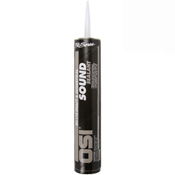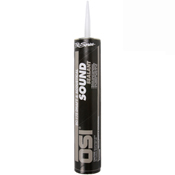Using Acoustical Sound Sealants for Noise Reduction
Acoustical sealants are necessary for soundproofing — they fill small cracks and joints in walls, ceilings and floors to reduce sound leakage. Also known as sound caulk, this material enhances the effectiveness of your soundproofing materials. Soundproof Cow offers acoustical sealant by the case or tube so you can add the finishing touch to your project.
What Makes Acoustical Sound Sealant Effective?
Acoustical caulk fills and expands in the cracks where you apply it, providing a tight seal to prevent sound from coming in or escaping. Some specific characteristics of acoustical sealants that make them effective include:
- Flexibility: Acoustical sealants are made with latex to provide permanent flexibility. The sealant will hold its airtight seal over time, accommodating movement without hardening or cracking.
- Adhesion: These sealants adhere to several building materials, including wood, metal, drywall and concrete. Their versatility makes them suitable for any project.
- Acoustic properties: These sealants are created to absorb sound and dampen vibrations through the elements of a building.
Versatile Applications for Acoustical Sealant
Acoustical sealants are extremely versatile in residential and commercial settings. Sound caulk is effective in offices, home recording studios, schools, multipurpose spaces, gyms and medical spaces. Once it is in place and dry, it can be painted to fit any aesthetic.
Tips for Applying Acoustical Sealants
Many contractors and DIYers turn to acoustical sealants because they are easy to apply. Here are some tips as far as the tools you will need, how to prepare, and best practices for achieving optimal results.
1. Gather Your Tools
All you need to apply acoustical sealant is a caulking gun and a utility knife to cut the tube’s tip to size. A caulking gun makes the application process easy and precise for the best results.
2. Prep the Application Area
Before acoustical caulking, be sure to clear the area of dust, debris or any residue. If you use a cleaning solution, give the area some time to dry completely. A clean surface helps ensure the sealant adheres properly.
3. Follow Best Practices for Application
When it comes time to apply your sealant, the process is fairly straightforward. Follow the included instructions and a few best practices:
- Cut the tip at a 45-degree angle for precise application.
- Apply the sealant in a continuous bead.
- Smooth the sealant with your finger or a caulking tool for a neat finish.
- Allow the sealant to dry completely before testing its effectiveness.
Improve Your Soundproofing Strategy With Soundproof Cow
Acoustical sealants are vital components of any soundproofing strategy. At Soundproof Cow, we offer water-based, VSO-compliant OSI® Pro-Series® soundproofing sealants. When you use them with our isoTRAX® Soundproofing System, you can experience unmatched noise reduction and draft prevention.
The Soundproof Cow team is here to help you find the soundproofing strategies you’re looking for. Reach out to us today to learn more about how we can transform your space!





